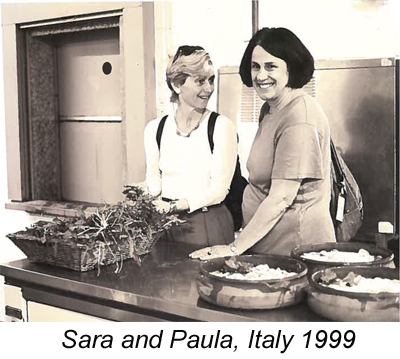Share This
Paula Wolfert Revels in the Mediterranean Lifestyle
“The fox,” you see, “knows many things,” wrote the ancient Greek writer Archilochus, “but the hedgehog knows one big thing.” For all the fox’s cunning, he is defeated by the hedgehog’s one great defense—-rolling himself up in a ball to protect himself on all sides with his coat of prickly quills.
About fifty years ago, the British philosopher Sir Isaiah Berlin, wrote an essay in which he placed writers into two camps. The foxes were people who pursued their ends from many directions at the same time. The hedgehogs were those who saw the world through the prism of a single organizing idea. Sir Isaiah didn’t imply a value judgment. For example, he considered Dostoevski, Dante, Ibsen, and Proust, to be hedgehogs, and Tolstoy, Shakespeare, and Moliere to be foxes. And of course every fox has a little hedgehog in him, and vice versa.
In regard to my own work as a culinary writer, over the last thirty years, I definitely consider myself a hedgehog. Why? Because I view food through the lens of my love and idealization of the Mediterranean style of life.
My approach to the Mediterranean is based on a myth—-an ideal, shared by many of us, of a robust, simple, and sensual lifestyle far from the madding
crowds of our competitive North Atlantic culture…and not easily transported. Hedgehog-like, I roll myself into a shell, closing myself off from those culinary foxes who mix and match the worlds cuisines and claim that culinary authenticity is a sham. Culinary globalization is the way of the fox. My way, and also the way of the Slowfood Movement, and if I may be a little presumptuous, the organization, Oldways, is the way of the hedgehog.We hedgehogs champion bio-diversity and ecology, home-made and hand-made food products, regionalism in food production, slow careful cooking and slow eating, the conviviality of the table, taking pleasure in living as well as eating—-taking time to, in the old phrase, “smell the roses.”
It seems amazing that just 50 years ago the US organic movement got underway thanks to vegetarians, while the sophisticated foodies of that time were busy cooking chic French dishes like ouefs en gelee and tournedos rossini. Those of us who yearned for “gen-u-ine” Mediterranean food could only find it in immigrant communities or reading Elizabeth David and dreaming.
Back in those days, I’d go to Astoria, Queens, where, as I remember, posters showing white villages and azure blue seas plastered the walls of Greek restaurants. I think the place I liked best was called Neptune—or maybe it was Apollo. I don’t really remember. What I do remember is my impression of Greek food—-that it featured lemons, bay leaves, crushed oregano, fresh dill and carafes of retsina wine. These Greek restaurants were fun—-as were the Italian places that offered pizza and spaghetti and meatballs served on tables covered with red and white tablecloths, lit by candles stuck in old straw covered chianti bottles. Mediterranean cooking didn’t make much of an impression. But, as I said, it seemed fun.
When, in the 1970’s, says food writer Terry Durack, “French food was promptly sent where it had never gone before: into a food processor” and entered into the world of nouvelle cuisine, processing vegetables, fruits and fish into terrines and mousses, the first honest ethnic cookbooks came on the market. The books were for “The Happy Few” who had traveled, and thus gained an old world respect for traditional dishes properly made with the proper ingredients. The recipes were imparted by researchers, and also by authentic ethnic cooks. Even back then it was hard to find the right ingredients. But bolstered by good new restaurants, and articles in food magazines, a demand was starting to build.
As a hedgehog food writer, who has written almost exclusively about the cuisines of Mediterranean, I was searching back in the 70’s, when I was working on my second book, Mediterranean Cooking, for a single, over-arching organizing principle. I decided not to think in terms of courses, or in terms of national schools, but to organize my dishes, collected from throughout the whole Mediterranean region, in terms of key flavors and tastes: garlic and oil; olives, eggplant, tomatoes, peppers, chickpeas, lentils and beans, all sorts of grains, herbs and spices, yogurt and cheese, nuts, and lemons, oranges, figs and dates. I was fascinated by the many ways these ingredients were mixed and matched, jig-sawed by local cooks into a nearly limitless number of Mediterranean dishes. I felt that that diversity of approaches to the same ingredients constituted the unity of Mediterranean cooking.
Over the last thirty years, a huge variety of dishes have been unearthed by us hedgehog-driven food writers, and slowly found their way into American homes and the American diet. My own style is to write these recipes, to romance them. That is what I like to do because I like to cook, too. I tell stories that set the food in place. If people are to have fun cooking a dish, they should see it in context. So I give stories: Who ate this? Why? What’s the excitement? I structure all this around the recipe so you will want to make it, so it will be an adventure. But I don’t think of recipes as documentation. Though I want to convey the integrity of a dish, I’m willing to change a recipe to make it work here in America.
Over the last decade our farmers markets have developed to a state that is almost magical: The farmers are passionate about their products and the consumers are eager to buy. One can now cook Mediterranean right here in America. Everything is here in America, everything —- and without the pollution. Mediterranean food has become our food, too. When we speak about Mediterranean cooking existing here in America, we are describing a developing culinary community that has learned what us hedgehogs have long known: the importance of eating real food —- food that has history, romance, great taste and is good for you. That’s what we have here now. There has never been a better time to make the dishes you fall in love with when you go abroad. You can have your culinary adventures, and you come home and relive them. Even our culinary foxes now know what Mediterranean food is all about.
We know that good fresh ingredients are seasonal and essential, but let’s not forget the Mediterranean larder. I know it’s hard to romance food when it comes packaged or flash-frozen, but don’t laugh! Mediterranean canned food is coming to your neighborhood grocer and you will like it. The variety of quality canned tuna, sardines, anchovies, olives and red peppers can be spectacular. Even great chefs, such as Alain Ducasse use canned Spanish red peppers. There is now even a highly acclaimed restaurant in Barcelona described by Amanda Hesser in the New York Times, where everything offered is from cans.
In my opinion the one component of Mediterranean cuisine still lacking here is the Mediterranean style of eating. Because it’s not just what you eat, but also how you eat it, and, of course, how you digest.
How to get to this next level? Oh, I would bring back the leisurely three martini lunch—— with the emphasis on the leisure, but drop the martinis. An Australian journalist pal once said to me:”—-a nibble leads you to a bite which leads you to another in one long conversational flow. Why are we able to do that instinctively when we’re holidaying around the Mediterranean but we can’t seem to do it back home? Must we have long hours of sunshine, the buzzing of bees, and the escapist joy of being abroad to fully enjoy the myth?”
I say we can do it here. It will take time… and obviously a change of consciousness. But isn’t that really what we’re here to do? Even if it’s just on a page…that world has real beauty…it’s a life force, a life cycle, that I as a confirmed Mediterranean-oriented culinary hedgehog love and still romanticize. Now I ask you what’s wrong with that?



Add a Comment